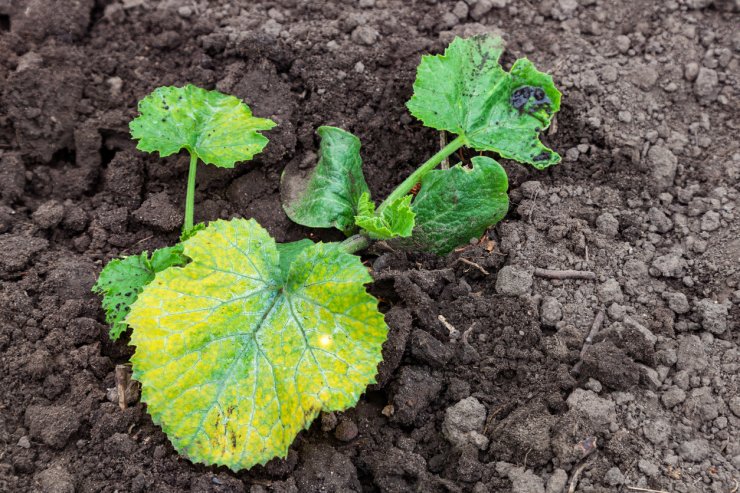
Sick squash plant.
The best way to prevent crop loss due to common squash diseases is vigilance. Squash plants are susceptible to diseases. Spot diseases on your squash plants sooner so you can treat plants before they are destroyed by disease and can successfully manage symptoms.
Here is a three-step approach to keeping vigilant about the presence of squash plant diseases:
- Research the risks. Find out about squash diseases that are prevalent in your geographic area. When possible, buy disease-resistant squash plant varieties to avoid diseases in the first place—many hybrid squash varieties have been specifically designed to resist certain diseases.
- Examine plants daily. Check your squash plants every day to be sure no disease symptoms are present or emerging.
- Spot diseases early. Catch and treat disease quickly so your plants can recover and thrive.
Blossom end rot
When the ends of your squash plants shrivel and turn brown, this is usually a sign of blossom end rot. This condition occurs where plants lack calcium, either because they can’t get enough from the soil or because something blocks them from taking it up.
Prevention: Perform a soil test before you plant to check calcium and acidity levels. Low pH (under 5.5) means that plants will have trouble absorbing minerals from the soil. Treat with lime three months before planting to increase your soil’s alkalinity.
If your soil pH is fine but you still see signs of blossom end rot (and these signs don’t persist throughout the whole growing season), plant stress may be the cause. Drought, wet soils, and unusually cool or hot weather can strain plants and prevent them from absorbing minerals effectively.
Do your best to ensure plants receive even watering from drip irrigation or soaker hoses and protect them from weather extremes.
Powdery mildew
When mature leaves have powdery spots on upper and lower surfaces, this is the first sign of powdery mildew. Eventually these spots may grow to form large patches, covering leaves and stems. The leaves lose their normal dark green hue, turn pale yellow, then brown and finally shrivel, leaving the squash exposed to sunburn.
This fungus can weaken plants, reduce fruit set, and cause premature ripening.
Prevention: Since powdery mildew infections thrive in warm, dry conditions —contrary to what you might have thought—and closely planted crops, be sure to give your squash plants adequate room to increase airflow. Destroy any diseased plant debris, plant resistant varieties when possible, and keep the garden free of weeds.
Also, the disease overwinters and is spread to successive generations of squash, so once again, crop rotation is your friend.
Control: If powdery mildew appears, pick and dispose of affected leaves (not in compost—it will survive there and attack any plant that is treated next year with that compost).
You can spray leaves with a solution of neem oil and water (2 tablespoons of neem oil concentrate to one gallon of water). This will help reduce or eliminate powdery mildew in as little as 24 hours.
You may also use a fungicide, but remember that fungicides only work early on in an infection, by preventing the infection from spreading. Here’s where daily vigilance comes in again!
Pull severely infected plants; they will not produce well.
Mosaic virus
Squash mosaic virus appears as dark green and blistering patches on the leaves. Leaves and fruits become mottled, bumpy, and misshapen. Beetles—including the leaf beetle and spotted cucumber beetle—transmit the virus after feeding on other infected plants. It can also be spread by infected seed.
Prevention: Choose disease-free certified seed. A clean garden and constant vigilance are again your friends. Clean your garden of spent plants at the end of the season.
Control: Remove and destroy any infected plants, and use neem oil or a fungicide if necessary.
Please tell us if you use organic or chemical methods to prevent and defeat squash diseases. Why did you choose that method? Please post your comments below.


 Previous
Previous

